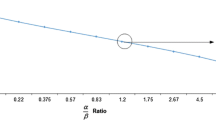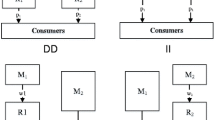Abstract
We use a newsvendor model to investigate equilibrium contracting strategies and their impact on the members in two competing supply chains that are subject to inventory inaccuracy. The suppliers are Stackelberg leaders and can choose either a wholesale-price contract or consignment contract. As a result, we analyze three cases: the wholesale price contract case, consignment contract case, and hybrid contract case. We first analytically derive the optimal outcomes of each case and then analyze the equilibrium behaviors of suppliers and retailers under both symmetric and asymmetric settings. Our results show that the consignment contract is no longer the dominant strategy for dominant suppliers when inventory inaccuracy is considered, even though it is considered as the channel-coordinating contract format in the traditional supply chain. Specifically, in the symmetric case, the wholesale price contract is the equilibrium contracting strategy when inventory inaccuracy is below a certain threshold. In the asymmetric case, the hybrid scenario occurs when the high-cost supplier chooses the wholesale price contract, and the low-cost supplier chooses the consignment contract when inventory inaccuracy is less than a certain value. Furthermore, our results demonstrate that the threshold point of inventory inaccuracy is interrelated with the channel cost-sharing rate and level of chain-to-chain competition between supply chains.



Similar content being viewed by others
Notes
For ease of exposition, the corresponding retailer, supplier in one supply chain, and the supply chain itself share the same inventory availability, although we assume that inventory inaccuracy occurs on the retailer’s side.
The supply chains’ profits increase as inventory availability increases; we do not present this here to save space.
References
Adida, E., & Ratisoontorn, N. (2011). Consignment contracts with retail competition. European Journal of Operational Research, 215(1), 136–148.
Altug, M. S., & Ryzin, G. V. (2013). Product quality selection: Contractual agreements and supplier competition in an assemble-to-order environment. International Journal of Production Economics, 141(2), 626–638.
Atali, A., Lee, H., & Ozer, O. (2004). Inventory control under imperfect information: Bounds, heuristics and approximations with demand prioritization. Working Paper. Stanford University, Stanford, California.
Avinadav, T., Chernonog, T., & Perlman, Y. (2015). Consignment contract for mobile apps between a single retailer and competitive developers with different risk attitudes. European Journal of Operational Research, 246, 949–957.
Bernstein, F., & Federgruen, A. (2005). Decentralized supply chains with competing retailers under demand uncertainty. Management Science, 51(1), 18–29.
Bian, J., Guo, X., Lai, K. K., & Hua, Z. (2014). The strategic peril of information sharing in a vertical-Nash supply chain: A note. International Journal of Production Economics, 158, 37–43.
Bian, J., Liao, Y., Wang, Y. Y., & Tao, F. (2020). An analysis of firm CSR strategies. European Journal of Operational Research. https://doi.org/10.1016/j.ejor.2020.03.046.
Boyaci, T., & Gallego, G. (2004). Supply chain coordination in a market with customer service competition. Production and Operations Management, 13(1), 3–22.
Cachon, G. P. (2003). Supply chain coordination with contracts. In S. Graves & A. Kök (Eds.), Handbooks in operations research and management science: Supply chain management, design, coordination and operation (Vol. 11, pp. 229–339). Amsterdam: Elsevier.
Cachon, G. P. (2004). The allocation of inventory risk in a supply chain: Push, pull, and advance-purchase discount contracts. Management Science, 50(2), 222–238.
Cachon, G. P., & Kök, A. G. (2010). Competing manufacturers in a retail supply chain: On contractual form and coordination. Management Science, 56(3), 571–589.
Camdereli, A. Z., & Swaminathan, J. M. (2010). Misplaced inventory and radio-frequency identification (RFID) technology. Production and Operations Management, 19(1), 1–18.
Cao, X., & Fang, X. (2019). Component procurement for an assembly supply chain with random capacities and random demand. Decision Sciences, 50(6), 1259–1280.
Chen, J., Chen, B., & Li, W. (2018). Who should be pricing leader in the presence of customer returns? European Journal of Operational Research, 265, 735–747.
Choi, M., Rabinovich, E., & Richards, T. J. (2019). Supply chain contracts and inventory shrinkage: An empirical analysis in the grocery retailing industry. Decision Sciences, 50(4), 694–725.
Dehoratius, N., & Raman, A. (2008). Inventory record inaccuracies: An empirical analysis. Management Science, 54(4), 627–641.
Demirag, O. C., Keskinocak, P., & Swann, J. (2011). Customer rebates and retailer incentives in the presence of competition and price discrimination. European Journal of Operational Research, 215(1), 268–280.
Fan, T. J., Tao, F., Deng, S., & Li, S. X. (2015). Impact of RFID technology on supply chain decisions with inventory inaccuracies. International Journal of Production Economics, 159, 117–125.
Fang, Y. E., Wang, Y. Y., & Hua, Z. S. (2016). Equilibrium contract selection strategy in chain-to-chain competition with demand uncertainty. Journal of the Operational Research Society, 67(5), 770–785.
Fleisch, E., & Tellkamp, C. (2005). Inventory inaccuracies and supply chain performance: A simulation study of a retail supply chain. International Journal of Production Economics, 95(3), 373–385.
Ha, A. Y., & Tong, S. (2008). Contracting and information sharing under supply chain competition. Management Science, 54(4), 701–715.
Heese, H. S. (2007). Inventory record inaccuracies, double marginalization, and RFID adoption. Production and Operations Management, 16(5), 542–553.
Hu, B., Meng, C., Xu, D., & Song, Y. J. (2018). Supply chain coordination under vendor managed inventory-consignment stocking contracts with wholesale price constraint and fairness. International Journal of Production Economics, 202, 21–31.
Hu, W., Li, Y., & Wang, W. (2017). Benefit and risk analysis of consignment contracts. Annals of Operations Research, 257, 641–659.
Kök, A. G., & Shang, K. H. (2007). Inspection and replenishment policies for systems with inventory record inaccuracy. Manufacturing & Service Operations Management (M&SOM), 9(2), 185–205.
Kök, A. G., & Shang, K. H. (2014). Evaluation of cycle-count policies for supply chains with inventory inaccuracy and implications on RFID investments. European Journal of Operational Research, 237(1), 91–105.
Leng, M., & Parlar, M. (2010). Game-theoretic analyses of decentralized assembly supply chains: Non-cooperative equilibria vs. coordination with cost-sharing contracts. European Journal of Operational Research, 204(1), 96–104.
Lim, Y. F., Wang, Y., & Wu, Y. (2015). Consignment contracts with revenue Sharing for a capacitated retailer and multiple manufacturers. Manufacturing & Service Operations Management, 17(4), 527–537.
Lu, F., Zhang, J., & Tang, W. (2019). Wholesale price contract versus consignment contract in a supply chain considering dynamic advertising. International Transactions in Operational Research, 26, 1977–2003.
Mersereau, A. J. (2013). Information-sensitive replenishment when inventory records are inaccurate. Production and Operations Management, 22(4), 792–810.
Pan, K. W., Lai, K. K., Leung, S. C. H., & Xiao, D. (2010). Revenue-sharing versus wholesale price mechanisms under different channel power structures. European Journal of Operational Research, 203(2), 532–538.
Paul, A., Rajapakshe, T., & Mallik, S. (2019). Socially optimal contracting between a regional blood bank and hospitals. Production and Operations Research, 28(4), 908–932.
Rekik, Y., Sahin, E., & Dallery, Y. (2008). Analysis of impact of RFID on reducing product misplacement errors at retail stores. International Journal of Production Economics, 112(1), 266–274.
Ru, J., & Wang, Y. (2010). Consignment contracting: Who should control inventory in the supply chain? European Journal of Operational Research, 201(3), 760–769.
Shi, J., & Zhang, G. (2010). Multi-product budget-constrained acquisition and pricing with uncertain demand and supplier quantity discount. International Journal of Production Economics, 128, 322–331.
Shou, B., Huang, J., & Li, Z. (2009). Managing supply uncertainty under chain-to-chain competition. Working Paper. City University of Hong Kong.
Spengler, J. J. (1950). Vertical integration and antitrust policy. The Journal of Political Economy, 58(4), 347–352.
Tao, F., Fan, T. J., Lai, K. K., & Li, L. (2017). Impact of RFID technology on inventory control policy. Journal of the Operational Research Society, 68(2), 207–220.
Tao, F., Fan, T. J., Wang, Y. Y., & Lai, K. K. (2019). Joint pricing and inventory strategies in a supply chain subject to inventory inaccuracy. International Journal of Production Research, 57(9), 2695–2714.
Tao, F., Yu, H., Fan, T. J., & Lai, K. K. (2020). Contract preference for the dominant supplier subject to inventory inaccuracy. Computers & Industrial Engineering. https://doi.org/10.1016/j.cie.2020.106323.
Thiel, D., Hovelaque, V., & Hoa, V. T. L. (2010). Impact of inventory inaccuracies on service-level quality in (Q, R) continuous-review lost-sales inventory models. International Journal of Production Economics, 123(2), 301–311.
Wang, F. Q., Fang, X. P., Chen, X. H., & Li, X. H. (2016). Impact of inventory inaccuracies on products with inventory-dependent demand. International Journal of Production Economics, 177, 118–130.
Wang, Y. (2006). Joint pricing-production decisions in supply chains of complementary products with uncertain demand. Operations Research, 54(6), 1110–1127.
Wang, Y., Jiang, L., & Shen, Z. J. (2004). Channel performance under consignment contract with revenue sharing. Management Science, 50(1), 34–47.
Wu, D., Baron, O., & Berman, O. (2009). Bargaining in competing supply chains with uncertainty. European Journal of Operational Research, 197(2), 548–556.
Xie, J., Zhou, D., Wei, J., & Zhao, X. (2010). Price discount based on early order commitment in a single manufacturer-multiple retailer supply chain. European Journal of Operational Research, 200(2), 368–376.
Xu, Y., Yin, R., & Dong, Y. (2016). Stockout recovery under consignment: The role of inventory ownership in supply chains. Decision Sciences, 47(1), 94–124.
Zhang, G. (2010). The multi-product newsboy problem with supplier quantity discounts and a budget constraint. European Journal of Operational Research, 206, 350–360.
Zhang, H. (2002). Vertical information exchange in a supply chain with duopoly retailers. Production and Operations Management, 11(4), 531–546.
Zhang, J., & Chen, J. (2013). Coordination of information sharing in a supply chain. International Journal of Production Economics, 143(1), 178–187.
Zhang, L. H., & Yang, H. X. (2019). Incentives for RFID adoption with imperfect read rates: Wholesale price premium versus cost sharing. Journal of the Operational Research Society. https://doi.org/10.1080/01605682.2018.1506252.
Zhao, J., Zhou, Y. W., Cao, Z. H., & Min, J. (2020). The shelf space and pricing strategies for a retailer-dominated supply chain with consignment based revenue sharing contracts. European Journal of Operational Research, 280, 926–939.
Acknowledgements
The authors are very thankful to the editor and the anonymous referees for their valuable suggestions to improve the quality of this paper. This paper was supported in part by National Natural Science Foundation of China (No. 71872064, 72071137, 71671119), in part by Shanghai Pujiang Program (18PJC025), in part by Qinglan Program of Jiangsu Province, and in part by the Fundamental Research Funds for the Central Universities (JKN022023001).
Author information
Authors and Affiliations
Corresponding author
Additional information
Publisher's Note
Springer Nature remains neutral with regard to jurisdictional claims in published maps and institutional affiliations.
Supplementary Information
Below is the link to the electronic supplementary material.
Rights and permissions
About this article
Cite this article
Tao, F., Xie, Y., Wang, YY. et al. Contract strategies in competitive supply chains subject to inventory inaccuracy. Ann Oper Res 309, 641–661 (2022). https://doi.org/10.1007/s10479-021-03969-6
Accepted:
Published:
Issue Date:
DOI: https://doi.org/10.1007/s10479-021-03969-6




